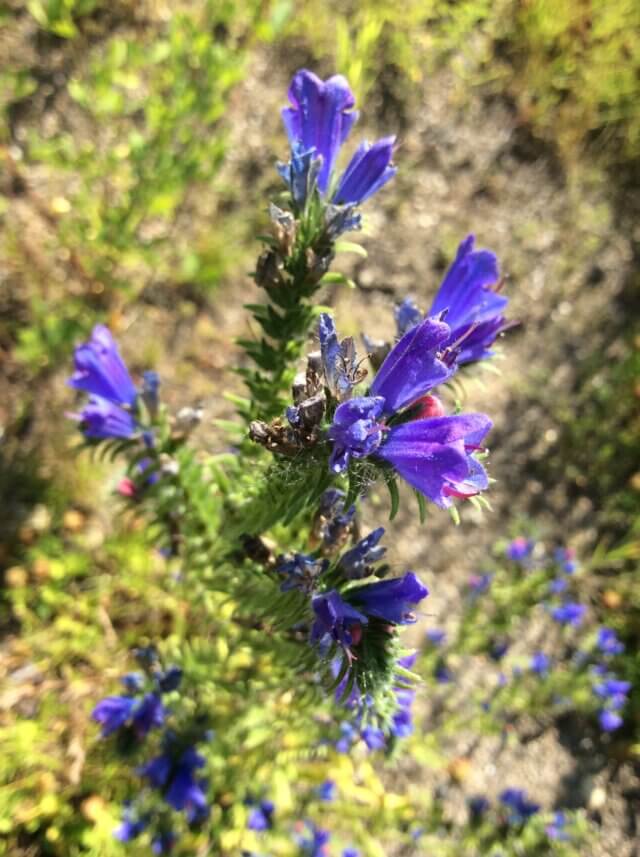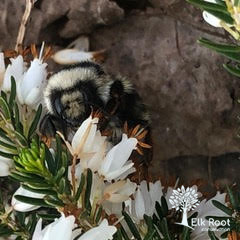Native Plants: Native plants are defined as those that are indigenous to a certain area, ecosystem or habitat. Because these species of plants evolved alongside native pollinators, it makes sense that they have a preference for native plants. They are also best adapted to the climate and soil they grew up in, so they are less fazed by challenges such as drought, meaning they tend to need fewer resources and care than other non-native plants.
Note: many of the native plants available at garden centres are actually cultivars- or commonly named nativar. A nativar can be a hybrid of two or more plants selected to breed or a clone of one particularly desirable wild plant. Clones are created via plant cuttings and are genetically identical to its parent plant. Hybrids are an intentional cross between two species of plant to produce aesthetically pleasing traits.
Nativars are not open pollinated. This means they lack genetic diversity and could cause the dilution of the genetic diversity of local native populations if they cross-pollinate. Suppliers listed in the EcoGarden list supply “straight” native species, as opposed to nativars.
Invasive Plants: Invasive plants are non-native plants that become well established because they do not  have any natural predators or controls.
have any natural predators or controls.
- These introduced, non-native species spread quickly and have the ability to out compete native plant species, impacting fragile ecosystems.
- Have been introduced to Canada either intentionally or accidentally. Human behaviour is the #1 contributor to the spread of invasive species
- Negatively impact biodiversity, species at risk, and water quality
Cultivated plants:Plants raised in cultivation which differ sufficiently from their wild ancestors or, if taken into cultivation from the wild, are worthy enough of distinction from wild populations for horticultural purposes to merit special names.
Climate Smart: All plants on the list meet ClimateSmart criteria:•
- Species that are in the mid to northern portions of their range. For most species that are at the southern end of their natural range, a garden is becoming increasingly inhospitable.
- Local native plants that are sourced from local plant populations or stock from nurseries in same ecoregion. Locally native plants that are still thriving in natural areas have adapted well to current levels of climate change.
- Species that are adapted to future projection of drought and changes in precipitation and temperature. All species have large hardiness zone range.
For more information see: Benefits of planting natives in a changing climate, Gardening with Climate Smart Native Plants
FireSmart: Selecting fire resistant plants and materials can increase the likelihood of your home surviving a wildfire. Trees that are flammable are not considered FireSmart. Note: that the plant list in the guide contains invasive plants. Please follow the EcoGarden list.
For more information see: FireSmart Guide to Landscaping, BC FireSmart manual-BC
WaterSmart: Our region experiences hot and dry summers, with water restrictions becoming more common. Consider landscape plantings that work with these conditions. Native and drought tolerant species look great and need far less help from us. WaterSmart plants are drought resistant or drought tolerant.
For more information see: RDCK WaterSmart program
WildSafe: Wildlife often use landscaping for food, shelter and security cover when travelling. While attracting beneficial insects and providing habitat for birds is desirable, avoid providing food and shelter to potential conflict species by:

- Limiting or omitting the use of fruit-bearing plants that may be highly attractive to bears, raccoons, and even coyotes. If you must have fruit-bearing plants, ensure they are not located near building entrances and windows.
- Avoid nut-producing trees that can be highly attractive to bears.
- Trim trees and shrubs so as to remove branches that could provide security cover close to the ground.
- Design your yard with clear sight lines and avoid creating blind-spots that allow wildlife to hide.
- Remove tree limbs that are adjacent to your home that would provide access to your home by raccoons, rats or squirrels.
- Avoid using herbicides that are harmful to wildlife or local pets.
- Do consider native plants that are best adapted to your local growing conditions and will be beneficial to local pollinators.
- Consider fencing, both physical and electric, to prevent access by wildlife.
For more information visit: WildSafeBC
Pollinators: Native Pollinators are essential to natural ecosystems. They help maintain healthy, productive native plant communities. Many animals, from birds to grizzly bears depend on insect-pollinated fruits and seed. Pollinating insects are a central part of the food web, being food themselves for birds, spiders, bats and fish.
They help maintain healthy, productive native plant communities. Many animals, from birds to grizzly bears depend on insect-pollinated fruits and seed. Pollinating insects are a central part of the food web, being food themselves for birds, spiders, bats and fish.
Bees are the most important group of pollinators. There are more than than 450 specie of native bees in British Columbia. Bees play a critical role in the pollination of food crops and provide important additional pollination services in areas where non-native honey bee populations are in decline. Most of British Columbiaʼs native bees are solitary and do not sting!
For more information see: Protecting native pollinators in the Columbia Basin, Creating a Monarch Waystation, Pollinators-Protection and stewardship, Xerces,
